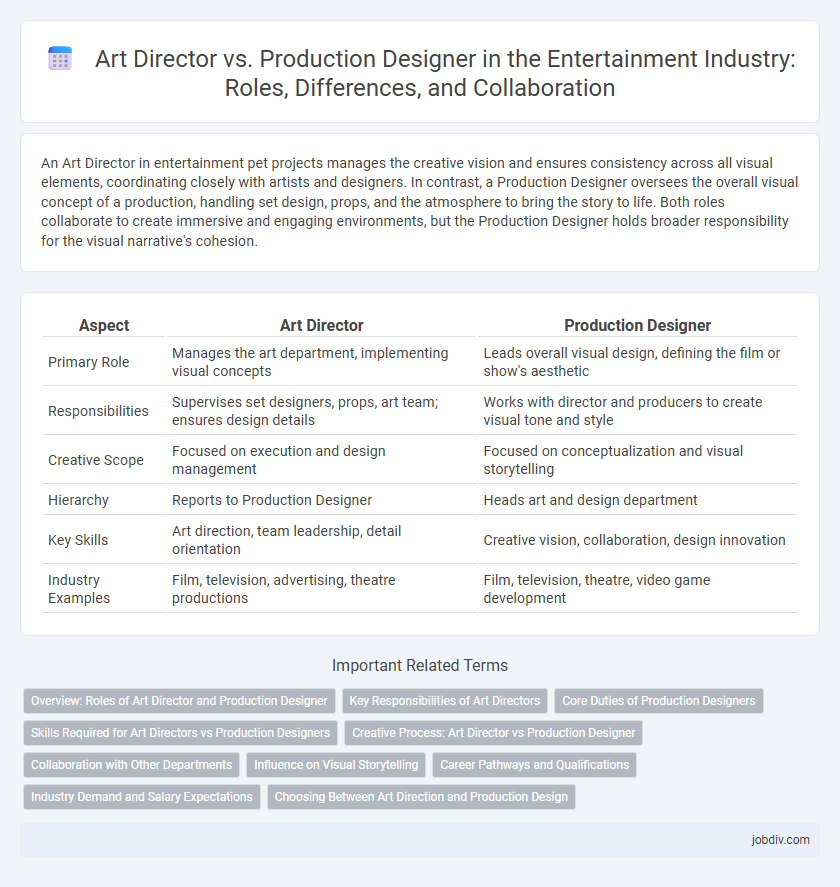An Art Director in entertainment pet projects manages the creative vision and ensures consistency across all visual elements, coordinating closely with artists and designers. In contrast, a Production Designer oversees the overall visual concept of a production, handling set design, props, and the atmosphere to bring the story to life. Both roles collaborate to create immersive and engaging environments, but the Production Designer holds broader responsibility for the visual narrative's cohesion.
Table of Comparison
| Aspect | Art Director | Production Designer |
|---|---|---|
| Primary Role | Manages the art department, implementing visual concepts | Leads overall visual design, defining the film or show's aesthetic |
| Responsibilities | Supervises set designers, props, art team; ensures design details | Works with director and producers to create visual tone and style |
| Creative Scope | Focused on execution and design management | Focused on conceptualization and visual storytelling |
| Hierarchy | Reports to Production Designer | Heads art and design department |
| Key Skills | Art direction, team leadership, detail orientation | Creative vision, collaboration, design innovation |
| Industry Examples | Film, television, advertising, theatre productions | Film, television, theatre, video game development |
Overview: Roles of Art Director and Production Designer
The Art Director manages the visual style and images in film, television, or theater, overseeing the creative team and ensuring the design aligns with the director's vision. The Production Designer develops the overall look and feel of the project, coordinating with the art department, set decorators, and costume designers to create a cohesive aesthetic. Both roles collaborate closely to establish the visual narrative, but the Production Designer holds primary responsibility for the conceptual design while the Art Director handles implementation.
Key Responsibilities of Art Directors
Art Directors oversee the visual style and imagery in film, television, and advertising, ensuring design consistency across sets, locations, and graphics. They collaborate with Production Designers to execute creative concepts, managing art department teams to meet production schedules and budgets. Their key responsibilities include interpreting scripts, creating storyboards, and supervising set construction and decoration to maintain the director's artistic vision.
Core Duties of Production Designers
Production Designers oversee the visual concept of a film or television production, crafting detailed sets, locations, graphics, props, lighting, and costumes to establish the overall aesthetic. Their core duties include collaborating closely with directors and cinematographers to create immersive environments that support the storytelling and emotional tone. They manage the art department's budget and schedule, ensuring all design elements align with the creative vision and production requirements.
Skills Required for Art Directors vs Production Designers
Art Directors require strong skills in visual storytelling, design software proficiency, and team leadership to effectively oversee the artistic aspects of film or theater production. Production Designers must excel in spatial awareness, set design, budgeting, and collaborative problem-solving to create cohesive visual environments that align with the director's vision. Both roles demand creativity and communication skills, but Production Designers focus more on overall visual concept and logistics while Art Directors concentrate on executing specific artistic elements.
Creative Process: Art Director vs Production Designer
Art Directors shape the visual style by interpreting the Production Designer's vision, focusing on details like set decoration, color schemes, and textures to enhance storytelling. Production Designers oversee the overall artistic concept, collaborating with directors and cinematographers to create cohesive environments that reflect the narrative tone. Both roles require deep creative collaboration, but Art Directors execute specific visual elements while Production Designers manage the broader design strategy.
Collaboration with Other Departments
Art Directors and Production Designers collaborate closely with departments such as set construction, costume design, and lighting to ensure a cohesive visual storytelling experience. The Production Designer leads the overall artistic vision, while the Art Director manages day-to-day execution and communication between teams. Effective collaboration maximizes creative synergy and maintains consistency across every element of the production design.
Influence on Visual Storytelling
Art Directors shape the visual narrative by managing the design elements and ensuring consistency in style, color, and mood, directly influencing the audience's emotional engagement. Production Designers oversee the overall visual concept, integrating set design, locations, props, and costumes to create a cohesive world that supports the story's themes and tone. Their combined efforts establish the film's aesthetic identity, driving the storytelling through immersive and deliberate visual choices.
Career Pathways and Qualifications
Art Directors typically begin their careers with a background in graphic design or visual arts, advancing through roles such as assistant art director to develop leadership skills in visual storytelling and team management. Production Designers usually hold degrees in film production, theater design, or architecture, gaining experience as set designers or art department coordinators before overseeing the overall visual concept of a film or stage production. Both careers demand strong creativity, proficiency in design software, and the ability to collaborate closely with directors and producers to achieve a unified aesthetic vision.
Industry Demand and Salary Expectations
Art Directors typically command salaries ranging from $60,000 to $110,000 annually, driven by strong industry demand in advertising, film, and television sectors. Production Designers earn higher averages, usually between $80,000 and $140,000, reflecting their crucial role in shaping visual storytelling on larger-scale projects. Rapid growth in streaming services and digital media increases demand for both roles, but Production Designers often experience greater salary growth due to their extensive responsibilities in pre-production design.
Choosing Between Art Direction and Production Design
Choosing between an Art Director and a Production Designer depends on the scale and vision of the entertainment project. Art Directors focus on executing the visual style under the Production Designer's guidance, managing set decoration and props, whereas Production Designers oversee the overall aesthetic, conceptualizing the environment and coordinating with various departments. For large-scale film or television productions, a Production Designer is essential to unify the creative vision, while smaller projects may benefit from a skilled Art Director to handle detailed visual elements.
Art Director vs Production Designer Infographic

 jobdiv.com
jobdiv.com